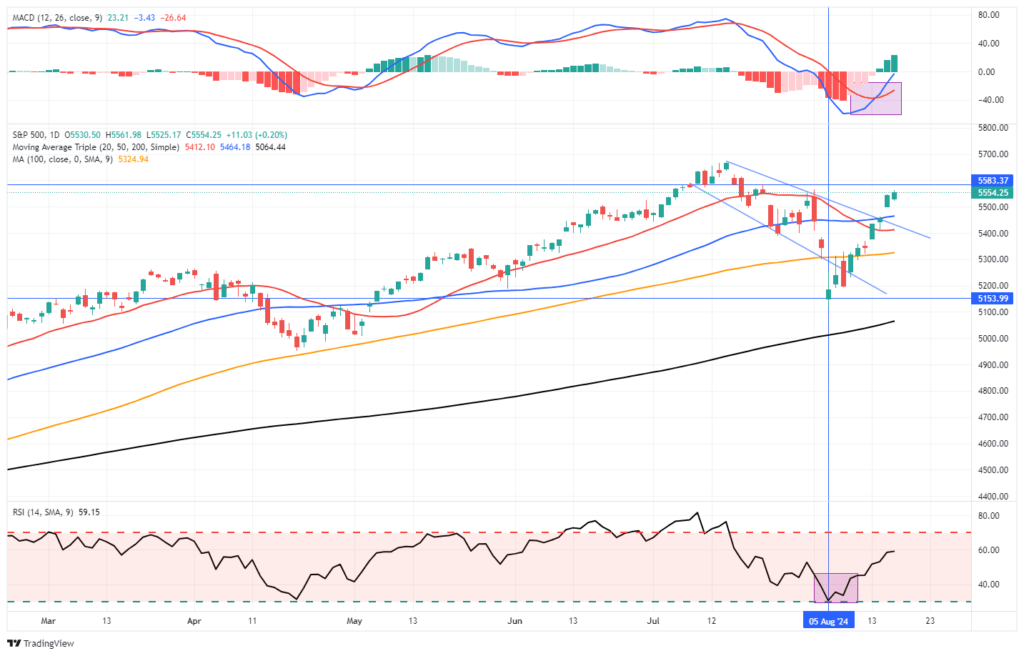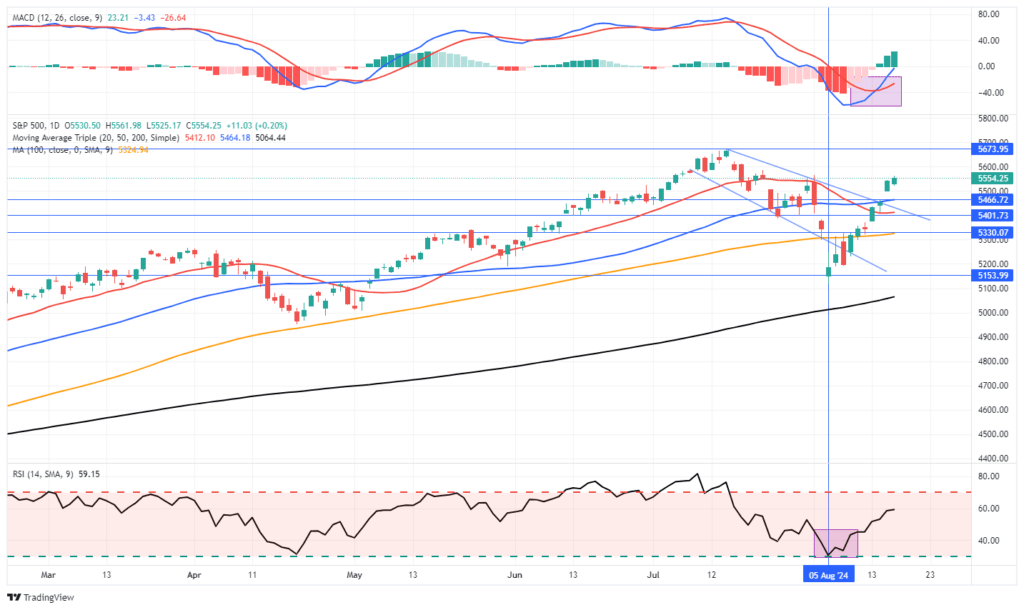The market’s 8.5% decline throughout August despatched shockwaves by way of the media and buyers. The drop raised considerations about whether or not this was the beginning of a bigger correction or a short lived pullback. Nonetheless, a robust reversal, pushed by investor shopping for and company share repurchases, halted the decline, main many to marvel if the worst is behind us.
Nonetheless, the image turns into extra nuanced as we study the technical ranges and broader market circumstances. Whereas the current bounce suggests the market decline could also be over, dangers stay—notably with the November election looming. Let’s dive into the small print.
The August Decline: What Prompted It?
August has traditionally been risky for markets; this yr was no exception. A mixture of things drove the S&P 500’s 8.5% drop:
- Elevated Curiosity Charges: The Federal Reserve’s continued dedication to preventing inflation led to elevated considerations about financial development slowing. That spooked buyers betting on a tender touchdown for the financial system when current financial information deteriorated.
- Weak Financial Information: A string of weaker-than-expected financial stories fueled the fireplace, together with slowing job development and declining client confidence. Issues a couple of potential recession began the sell-off in equities.
- The Yen Carry Commerce: A big rise within the Japanese Yen led to a fast unwinding of leverage utilized by establishments to extend portfolio returns. For extra data on the carry commerce, learn the linked article.
- Technically Overbought: As we mentioned repeatedly in June and July, the markets have been technically overbought and prolonged from long-term means. Solely an acceptable catalyst was wanted for a 5-10% market decline.
The correction, nevertheless, was unsurprising and one thing we repeatedly mentioned in June and July.
“Reversals of overbought circumstances are usually shallow in a momentum-driven bullish market. These corrections typically discover help on the 20 and 50-day shifting averages (DMA), however the 100 and 200-DMAs usually are not outdoors common corrective intervals.
If you happen to bear in mind, in March, we mentioned the potential for a 5 to 10% correction on account of most of the similar considerations famous above. That correction of 5.5% got here in April. We’re once more at a juncture the place a 5-10% is probably going. The one challenge is it may come anytime between now and October.“ – June twenty second
With that 5-10% correction full, many buyers marvel what induced the fast reversal final week, on condition that many elements main as much as the market decline stay.
The Reversal: Investor Shopping for and Share Repurchases
Regardless of the sharp decline, the market discovered help as a wave of investor shopping for and company share repurchases helped stem the losses. Right here’s how these elements performed out:
- Investor Shopping for at Key Assist Ranges: The S&P 500 discovered help on the 5153 degree, which coincides with the lows of the buying and selling vary again in April. Consumers stepped in because the market declined 3% in the course of the “Yen Carry” blowup. From there, shopping for quantity started to speed up.
- The chart reveals that the S&P 500’s bounce off that help was pivotal. With the markets oversold, the reversal of the decline started. Because the market low held, it supplied the boldness wanted for buyers to step again into the market.
- Company Share Repurchases: August additionally noticed a major enhance in company share buybacks. With inventory costs down, many firms took the chance to repurchase shares at a decrease value because the “blackout window” reopened, offering further help to the market. This company exercise helped soak up a few of the promoting stress and stabilized the market.

As we famous final week, we anticipated the “Mega-cap” shares to cleared the path increased, and we weren’t upset.


Notably, the market management, primarily development shares, has regained its footing, suggesting that the current correction is full and the bull market has resumed.


Nonetheless, the current rally has been very sharp and certain wants a breather earlier than additional beneficial properties might be made.


Technical Ranges to Watch
With the market rebounding, it’s essential to establish the important thing technical ranges that can decide the next potential entry factors to extend fairness exposures.
- Resistance at 5673: The primary important resistance degree for the S&P 500 is at 5673, which coincides with the current all-time highs. If the index can break above this degree, it will sign a continuation of the restoration and doubtlessly set the stage for a continuation of the rally. Nonetheless, if the S&P 500 fails to interrupt by way of this resistance, it may result in one other market decline to retest present help on the 50-DMA.
- Assist at 5330: On the draw back, the 5,330 degree stays a important help zone. That quantity will proceed to regulate increased as that’s the 100-DMA. Nonetheless, if that degree fails to carry, there’s solely minor help on the current lows earlier than a check of the 200-DMA close to 5100. Traders ought to watch the 100-DMA degree carefully, as a failure to carry right here may sign that the market’s current bounce was only a momentary reduction rally.


Whereas a pullback to help ranges to extend fairness publicity is probably going, are there extra substantial dangers that buyers ought to pay attention to?


The Dangers Forward: November Election and Financial Uncertainty
Whereas the market’s current restoration is encouraging, a number of dangers may derail the rally over the following few months.
- November Election: The upcoming election provides one other layer of uncertainty to the market. Traditionally, elections have a tendency to extend volatility as buyers react to potential coverage modifications. We may see sharp strikes in sectors like healthcare, power, and expertise relying on the end result. That uncertainty could result in elevated promoting stress, notably if the election outcomes are contested or result in a major shift in coverage.
- Financial Information: The market will stay extremely delicate to financial information releases. Any indicators of additional financial weak point may reignite fears of a recession, main to a different wave of promoting. Particularly, buyers will look ahead to updates on inflation, employment, and client spending. If weakening financial information impairs earnings estimates, the danger of market revaluation will increase.
- Federal Reserve Coverage: The Fed’s choices may even form market sentiment. If the Fed is keen to begin slicing charges, the market could quickly see that optimistically. Nonetheless, traditionally, a Fed rate-cutting cycle has not benefited increased asset costs, as fee cuts are inclined to coincide with slower financial development.


Threat administration is all the time essential when managing portfolios, as “nobody” is aware of with certainty what markets will do over the following week, a lot much less over the following month or quarter.
Conclusion: Is the Decline Over?
The market decline in August and subsequent reversal spotlight the market’s volatility and the significance of important technical ranges. Whereas the bounce off minor help and the surge in company buybacks recommend that the worst could also be over, important dangers stay.
With the polls now very tight between Trump and Harris, the potential for managers to “de-risk” portfolios stays elevated, given the uncertainty of outcomes. Moreover, that potential “de-risking” course of will coincide with the October blackout interval for share repurchases, eradicating one other supportive purchaser of equities. That mixture may arrange a possible “flash level” for volatility earlier than the November election.
We stay underweight equities and chubby money within the close to time period with our core Treasury bond holdings intact to hedge towards a pointy enhance in volatility. That positioning is unlikely to vary over the following two months, and we’re keen to sacrifice some efficiency in change for management over threat.
Whereas now we have mentioned these simplistic guidelines during the last a number of weeks, we proceed to reiterate the necessity to rebalance threat when you’ve got an allocation to equities.
- Tighten up stop-loss ranges to present help ranges for every place.
- Hedge portfolios towards important market declines.
- Take income in positions which were massive winners
- Promote laggards and losers
- Elevate money and rebalance portfolios to focus on weightings.
If an additional correction happens, the preparation lets you survive the influence. Defending capital will imply much less time spent getting again to breakeven afterward. Alternatively, it’s comparatively simple to reallocate funds to fairness threat if the market reverses and resumes its bullish development.
Investing during times of market uncertainty might be troublesome. Nonetheless, you’ll be able to take steps to make sure that elevated volatility is survivable.
Submit Views: 555
2024/08/20